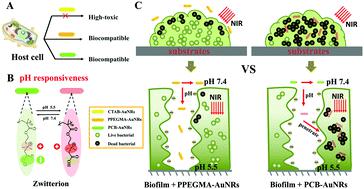当前位置:
X-MOL 学术
›
J. Mater. Chem. B
›
论文详情
Our official English website, www.x-mol.net, welcomes your
feedback! (Note: you will need to create a separate account there.)
Gold nanorods with surface charge-switchable activities for enhanced photothermal killing of bacteria and eradication of biofilm
Journal of Materials Chemistry B ( IF 6.1 ) Pub Date : 2020-03-10 , DOI: 10.1039/d0tb00298d Zhuangzhuang Qiao 1, 2, 3, 4 , Yan Yao 1, 2, 3, 4 , Shaomin Song 1, 2, 3, 4 , Meihui Yin 1, 2, 3, 4 , Min Yang 1, 2, 3, 4 , Daoping Yan 1, 2, 3, 4 , Lijiao Yang 1, 2, 3, 4 , Jianbin Luo 1, 2, 3, 4
Journal of Materials Chemistry B ( IF 6.1 ) Pub Date : 2020-03-10 , DOI: 10.1039/d0tb00298d Zhuangzhuang Qiao 1, 2, 3, 4 , Yan Yao 1, 2, 3, 4 , Shaomin Song 1, 2, 3, 4 , Meihui Yin 1, 2, 3, 4 , Min Yang 1, 2, 3, 4 , Daoping Yan 1, 2, 3, 4 , Lijiao Yang 1, 2, 3, 4 , Jianbin Luo 1, 2, 3, 4
Affiliation

|
The increasing growth and severity of bacterial biofilm infections and the appearance of multidrug-resistant bacteria pose alarming threats to public healthcare systems, mainly due to their formidable tolerance to conventional antibiotics. Different from the antibacterial mechanisms of antibiotics, gold nanorods (AuNRs) disinfect microbes by local heating induced by near-infrared (NIR) light irradiation; thus, they are potential disinfection agents. In an attempt to increase the biocompatibility and antibacterial activities of AuNRs against organisms in both planktonic and biofilm phenotypes, polymethacrylate with pendant carboxyl betaine groups was decorated on AuNRs (PCB-AuNRs) to afford AuNRs with pH-induced surface charge-transformable activities. The zwitterion-modified AuNRs demonstrated a pH-responsive transition from negative charge to positive charge; this confers the AuNRs with a change in functionality from biocompatible zwitterionic nanocomposites in healthy tissues (pH = ∼7.4) to enhanced antimicrobial cationic nanocomposites at acidic bacterial infection sites (pH = ∼5.5). AuNRs coated by polymethacrylate with pendant mPEG (PPEGMA-AuNRs) without surface charge transition activities were used for comparison. PCB-AuNRs presented better antimicrobial activity against Gram-negative bacteria (E. coli), Gram-positive bacteria (S. aureus) and their drug-resistant strains (MRSA and EBSL E. coli) than PPEGMA-AuNRs as a result of their pH-responsive surface charge transition activities. Moreover, PCB-AuNRs demonstrated deeper penetration into mature biofilms and better biofilm elimination activities than their non-surface charge-transformable counterparts. The results indicate that the designed zwitterion-coated AuNRs are a promising antibacterial agent for fighting bacterial infections.
中文翻译:

具有表面电荷可转换活性的金纳米棒,可增强细菌的光热杀灭和生物膜的清除作用
细菌生物膜感染的增长和严重程度的提高以及多药耐药细菌的出现对公共卫生系统构成了令人震惊的威胁,这主要是由于它们对常规抗生素的强大耐受力。与抗生素的抗菌机制不同,金纳米棒(AuNRs)通过近红外(NIR)光照射引起的局部加热来对微生物进行消毒。因此,它们是潜在的消毒剂。为了提高AuNRs对浮游生物和生物膜表型生物的生物相容性和抗菌活性,在AuNRs(PCB-AuNRs)上修饰了带有羧基羧基甜菜碱侧基的聚甲基丙烯酸酯,以提供具有pH诱导的表面电荷可转化活性的AuNRs。两性离子修饰的AuNRs表现出从负电荷到正电荷的pH响应转变;这使AuNRs的功能发生了变化,从健康组织中的生物相容性两性离子纳米复合材料(pH =约7.4)到酸性细菌感染部位的增强型抗菌阳离子纳米复合物(pH =约5.5)。进行了比较,使用没有表面电荷跃迁活性的,带有侧挂mPEG的聚甲基丙烯酸酯包覆的AuNR(PPEGMA-AuNRs)。PCB-AuNRs对革兰氏阴性细菌具有更好的抗菌活性(进行了比较,使用没有表面电荷跃迁活性的,带有侧挂mPEG的聚甲基丙烯酸酯包覆的AuNR(PPEGMA-AuNRs)。PCB-AuNRs对革兰氏阴性细菌表现出更好的抗菌活性(进行了比较,使用没有表面电荷跃迁活性的,带有侧挂mPEG的聚甲基丙烯酸酯涂层的AuNRs(PPEGMA-AuNRs)。PCB-AuNRs对革兰氏阴性细菌具有更好的抗菌活性(大肠杆菌,革兰氏阳性细菌(金黄色葡萄球菌)及其耐药菌株(MRSA和EBSL大肠杆菌)比PPEGMA-AuNRs更具活力,这是因为它们具有pH响应表面电荷转移活性。而且,与非表面电荷可转换的同类物相比,PCB-AuNRs可以更深入地渗透到成熟的生物膜中,并且具有更好的生物膜消除活性。结果表明,设计的两性离子包被的AuNRs是用于对抗细菌感染的一种有前途的抗菌剂。
更新日期:2020-04-24
中文翻译:

具有表面电荷可转换活性的金纳米棒,可增强细菌的光热杀灭和生物膜的清除作用
细菌生物膜感染的增长和严重程度的提高以及多药耐药细菌的出现对公共卫生系统构成了令人震惊的威胁,这主要是由于它们对常规抗生素的强大耐受力。与抗生素的抗菌机制不同,金纳米棒(AuNRs)通过近红外(NIR)光照射引起的局部加热来对微生物进行消毒。因此,它们是潜在的消毒剂。为了提高AuNRs对浮游生物和生物膜表型生物的生物相容性和抗菌活性,在AuNRs(PCB-AuNRs)上修饰了带有羧基羧基甜菜碱侧基的聚甲基丙烯酸酯,以提供具有pH诱导的表面电荷可转化活性的AuNRs。两性离子修饰的AuNRs表现出从负电荷到正电荷的pH响应转变;这使AuNRs的功能发生了变化,从健康组织中的生物相容性两性离子纳米复合材料(pH =约7.4)到酸性细菌感染部位的增强型抗菌阳离子纳米复合物(pH =约5.5)。进行了比较,使用没有表面电荷跃迁活性的,带有侧挂mPEG的聚甲基丙烯酸酯包覆的AuNR(PPEGMA-AuNRs)。PCB-AuNRs对革兰氏阴性细菌具有更好的抗菌活性(进行了比较,使用没有表面电荷跃迁活性的,带有侧挂mPEG的聚甲基丙烯酸酯包覆的AuNR(PPEGMA-AuNRs)。PCB-AuNRs对革兰氏阴性细菌表现出更好的抗菌活性(进行了比较,使用没有表面电荷跃迁活性的,带有侧挂mPEG的聚甲基丙烯酸酯涂层的AuNRs(PPEGMA-AuNRs)。PCB-AuNRs对革兰氏阴性细菌具有更好的抗菌活性(大肠杆菌,革兰氏阳性细菌(金黄色葡萄球菌)及其耐药菌株(MRSA和EBSL大肠杆菌)比PPEGMA-AuNRs更具活力,这是因为它们具有pH响应表面电荷转移活性。而且,与非表面电荷可转换的同类物相比,PCB-AuNRs可以更深入地渗透到成熟的生物膜中,并且具有更好的生物膜消除活性。结果表明,设计的两性离子包被的AuNRs是用于对抗细菌感染的一种有前途的抗菌剂。











































 京公网安备 11010802027423号
京公网安备 11010802027423号